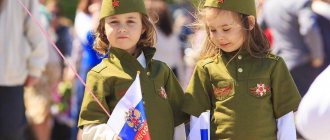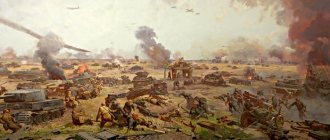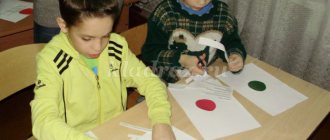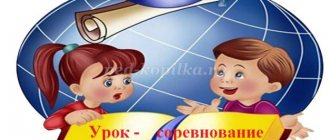Excursion to the school museum, 7th grade. Topic: Great Patriotic War
Scenario of an excursion to the school museum dedicated to the 71st anniversary of Victory in the Great Patriotic War.
“We remember, we honor and we are proud!”
Excursion to the school museum Author: Zhbanov Alexander Semenovich, head of the school museum of the Municipal Budgetary Educational Institution “Perkhlyayskaya Secondary School” of the Ruzaevsky District of the Republic of Mordovia Purpose: Conducting an excursion to the school museum under the section “No one is forgotten, nothing is forgotten...!” Objectives: To promote broadening of horizons and cognitive interests, to cultivate spiritual, moral and patriotic feelings. Description: Tour of the section “No one is forgotten, nothing is forgotten..!” held on the eve of Victory Day or Defender of the Fatherland Day. Participants in the excursion can be schoolchildren of any age, teachers and village residents. The excursion can be used to conduct a literary and musical composition. Type of excursion - active (The guides use the method of telling and showing) 1st guide - Hello, dear guys, teachers and guests! My name is …. I am a 7th grade student, I am a member of the Council and a tour guide at our school’s museum. 2nd tour guide - Hello! My name is …. I am an 8th grade student, I am also a member of the Council and a tour guide at the school museum. 1st tour guide -Our school museum was founded in 2010. Museums serve as a source that replenishes the spiritual forces of society, preserves collective memory, enriches and develops the intellect of the nation. “Memory is the staff on which a person relies in his life’s journey” - these wonderful words belong to the famous writer Viktor Astafiev. They fully reflect the meaning and meaning of the creation and existence of museums. In our school, the museum is the center of patriotic work. 2nd guide - Our whole country is preparing to celebrate the 71st anniversary of Victory in the Great Patriotic War. Today we dedicate our excursion “Remember, Honor and Proud” to this significant date! 1st guide - The central place in our museum is occupied by the exhibition “No one is forgotten, nothing is forgotten. This section of the museum in memory of the great feat that was accomplished by the natives of our region, our grandfathers and great-grandfathers, is intended to show that we all remember the veterans, their heroism, without which our common future would be impossible. Our museum stores photographs, documents and personal belongings of some of our fellow countrymen who heroically fought on the fronts of the Great Patriotic War (demonstration with a short story about significant things and documents)
Quiet music sounds 1st reader: Centuries will pass, words will disappear from life, Such as war, attack, battle. But we will honor those who once fell for the Fatherland forever - this is a holy duty! 2nd guide -At 4 o'clock in the morning on June 22, 1941. Hitler's Germany treacherously attacked the Soviet Union without declaring war. Thousands of enemy guns opened fire on Soviet border outposts, and German planes bombed our cities. 1st guide -Hitler's troops invaded Soviet soil. The Red Army and Navy received orders to repel the enemy attack. The Great Patriotic War of the Soviet Union against Nazi Germany began. It became the main, decisive component of the Second World War. The Soviet people, full of anger and indignation, took possession of an unshakable determination to give a crushing rebuff to the aggressor. All residents of the great country - workers and collective farmers, intellectuals, people of various nationalities and professions swore allegiance to the Fatherland. And, like an alarm bell calling the people to battle with the enemy, like an oath to the Motherland, the song “Holy War” sounded in those days, amazing in its power and harsh beauty. Phonogram. (Verse, chorus) 2nd guide (Exhibition “They Fought for the Motherland”)
-More than four hundred residents of our village were called to defend our Motherland. Among them are Alexey Maksimovich Tingaev, Vasily Trofimovich Lukachev, Nikolai Ivanovich Pyanzov, Stepan Vasilievich Narvatov and many, many others. (Showing photos). Unfortunately, in our village there is not a single veteran of the Great Patriotic War left alive. But we remember the fearless feat of our fellow countrymen and are proud of them. This is what is written in one of the articles by Nikolai Andreevich Kruchinkin, director of the Republican Memorial Museum of Military and Labor Glory: “Tankman Ivan Makulov, a native of the village of Perkhlyai, Ruzaevsky district, fought bravely in the bloody battles of Stalingrad. Its crew destroyed 17 guns, 7 tanks, and 250 fascists in just one battle.” 1st guide (Exhibition “Heroes of the Fatherland”)
-In every city and town, almost every village there are monuments and obelisks in honor of the heroes of the Great Patriotic War, places of worship for the blessed memory of the courageous and brave sons and daughters of the Fatherland. Our museum contains extensive information about the heroes of the Soviet Union, natives of our region. We remember and honor the feat of Anatoly Nikolaevich Kornelaev, Anatoly Petrovich Rubtsov, Fedor Pavlovich Surkov, Alexander Arkhipovich Vinokurov, Sergei Ivanovich Vandyshev, Alexander Pavlovich Silantiev. In the city of Ruzaeka, the Walk of Fame was founded in honor of the Heroes of the Soviet Union. 2nd tour guide (Memorable stele with the names of fallen fellow countrymen) -More than 250 of our fellow countrymen did not return from the battlefields. 1st Reader At the mound of a mass grave I stand quietly, like a memory, squeezing my civilian cap in my stiff fingers. Under the dark paws of fir trees, In the deep earth, as in a dream, You silently and faithfully carry out long-term service to the country. 2nd reader With all our human faith, And with our thoughts and our hearts, We believe the dead soldiers, And the dead believe the living. So eternal glory to the slain And eternal glory to the living! 1st guide - Let's honor the memory of our fellow countrymen with a minute of silence (metronome) 2nd guide (Exhibition “Participants of the Labor Front”)
-Victory would have been impossible without the great feat of the people of the Labor Army. During that harsh time, many boys and girls from our village tirelessly dug trenches and worked in the fields, obtaining bread for our Army. Among them are Elizaveta Leontievna Isaeva, Nikolai Fedorovich Narvatov, Vasily Trofimovich Ruzaev and many others. 1st guide -From the memoirs of labor front participant Elena Fedorovna Nadorova: “There was not a single healthy adult man left in the village. The whole burden fell on the shoulders of boys, girls, women and old people. After a short course for machine operators, I became a tractor driver. The work was hell. Tractors at that time were open and without cabs. All the dust and fumes settled on my face, making my eyes watery and making it hard to breathe. They worked in the field both day and night. It was a hungry time, I wanted to eat all the time. It was very scary for young girls to work at night. There were forests all around, and deserters were hiding in them. But we didn’t complain, because we knew that with our work we were helping our soldiers defeat the damned enemy.” 1st reader Again, our grandparents sadly remember the past: “This is our bitter Victory, Drenched in blood and lead.” Hardships and troubles did not break me. Fascism has fallen. The end of the war has come! This common Victory of ours Gave life to you and me! Victoria Kalanchina 2nd guide (Exhibition “Afghan Veterans - Graduates of Our School”) - Our grandfathers and great-grandfathers, winners of the Great Patriotic War, did not think that their children and grandchildren would have to fight and die again. It seemed that after such a terrible war, eternal peace would come. War is a cruel and terrible phenomenon, but as long as hatred and malice exist on Earth, wars will also exist. 1st guide -On the eve of the Great Victory holiday, it is impossible to remain silent about Afghanistan and Chechnya.
The war in Afghanistan continued for 10 terrible years. About 600 thousand people. went through this war. Among them are graduates of our school...Erofeev Vladimir Petrovich, Poldyaev Anatoly Viktorovich, Poldyaev Anatoly Vasilievich, Ruzaev Vasily Grigorievich, Marychev Alexander Viktorovich. Poldyaev Anatoly Vasilievich was awarded the Order of the Red Star. 2nd guide - Tens of thousands of Russian children went through the war in Chechnya, among them there are many guys from our region, including Vladimir Vladimirovich Markin, a graduate of our school. 12 young guys from our region died in those terrible wars. Their feat is a feat of faith, oath, and duty. 2nd reader No, courage does not happen by chance, It was born in the soul of a soldier, When he does not forget about his friends And does not think of himself apart from his homeland 1st guide - Time inexorably does its job. The war goes deep into history. And God forbid that no one has to go through it again. War only destroys everything in its path. We don't want any more war! 2nd guide - To study well and become real citizens of our country, to protect and increase what was won by the blood and sweat of our ancestors - this is our sacred duty. We will strive to become good specialists and help strengthen our Russian state! 1st tour guide - With these words I would like to end our tour. All the best to you, health, joy, confidence in the future, peace and harmony.
A tour of all sections of the museum can be taken here /blogs/jbanov-aleksandr/yekskursija-po-stranicam-shkolnogo-muzeja.html
We recommend watching:
Scenario of the competition program for Victory Day in an elementary school Conversation for May 9 - Victory Day for students in grades 6-8 Project for Victory Day - May 9 at school, grade 7 Extracurricular event. Primorsky Territory during the Second World War 1941 - 1945, grades 7-10
Similar articles:
History Game - World War II Quiz, Grade 7
Scenario of extracurricular activities for Victory Day in elementary school
Class hour on the topic May 9, Victory Day, grade 10
Class hour on the topic May 9, Victory Day, grade 9
Class hour for Victory Day - May 9, 2nd grade
Extracurricular activity “Excursion to the school ethnographic museum
4 guide
. Here are irons that were heated with coals. And how much dexterity and skill was needed not to stain a snow-white collar with soot! In our museum we also have irons made of solid cast iron. One of these was recently found in Novosibirsk while digging up a vegetable garden. Student Yangol Nastya brought the iron. Here is a grip, a miraculously preserved wooden shovel. They were given to students by Dima Mikhailov. Look, guys, how the housewife used a grab handle to get the cast iron out of the stove. (shows). Krynki and rubles were brought from the Altai Territory by G.V. Dymova. Until recently, mortars and chaff were collecting dust in the attics in the village of Skala.
4
1 tour guide.
Here's a big trough. In it, cabbage was cut with a chop, preparing it for the winter. They could also use it for washing, like the old woman from Pushkin’s fairy tale about the goldfish. This is a spinning wheel, a sieve, cast iron. Not a single housewife could do without these things. Well, about the samovar is a separate conversation. I’ll now show you his device (shows a place for cabbage soup, porridge, tea). It melted into small splinters and cones. The pipe was led out the window. Often peasant houses had only one room. A cradle was hung from the ceiling beam. So that the child would not be distracted from work, the housewife took a rope, tied one end to the cradle, and the other to the leg, and when the child cried, she rocked the cradle, pulling the rope with her foot, while she herself spun, knitted or embroidered patterns on clothes, which were very important. The circle at the bottom of the shirt, even embroidered, and red in color, is a symbol of the sun, fire. The edge of the hem, sleeves, and collars were protected with embroidery so that “evil spirits” could not penetrate.
2 guide
. Now let's go to the third room. Before us is like stills from an old movie. Just recently, our grandmothers had such a situation. A bookcase, a Singer typewriter, suitcases, a lot of figurines, a bed with a mountain of feather pillows, a soft feather bed, a hanging lace valance. And... a gramophone. I’ll now take the handle, wind it up, and you will have the opportunity to listen to the voice of a singer from the past (starts up the gramophone).
3 guide
. Our museum exhibits temporary exhibitions. Today you can get acquainted with Russian headdresses that were worn in different regions of our country. In the southern provinces - magpie, kichka - headdresses of bright colors with golden accents. “Magpie” is a headdress in the shape of a horseshoe or a bird’s tail. "Kichka" - a duck rocking on the water). Horns symbolized wealth, prosperity, strength, greatness. It was believed
5
that horns help a woman become a mother.
4 tour guide.
In the northern provinces, headdresses are of more muted tones, richly decorated with pearls, pearl mesh, and gold embroidery patterns. Amazingly thin and delicate in color, shimmering like a June night. Pearls glow softly, like small snowflakes or stars, they twinkle in beautiful headdresses. “Kokosh” - rooster and hen - this is how you can literally translate the name of this headdress, which symbolized happiness and unity in marriage, the warmth of the hearth, carried the idea of fertility, and with it the infinity of life cycles, affirming the enduring value of human existence.





